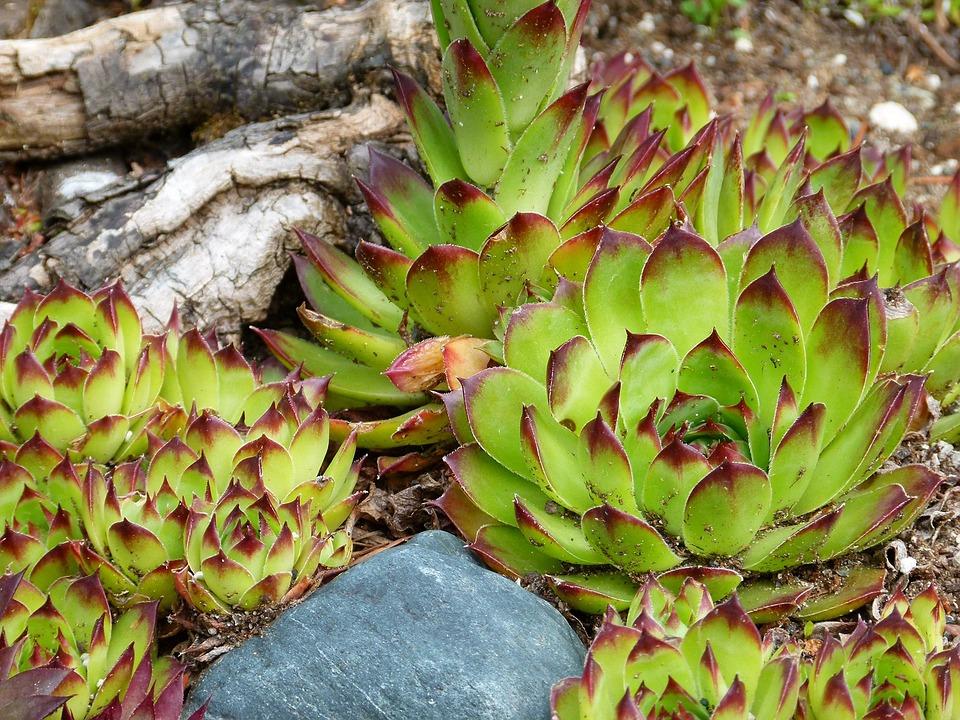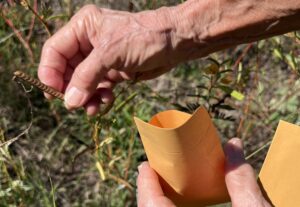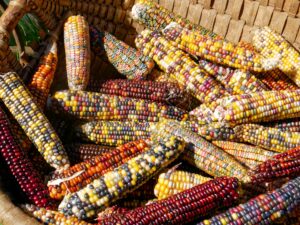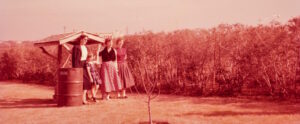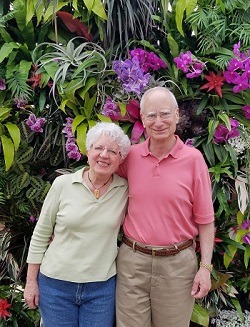
Trudy and Charles Hess
Q: How did you come to be interested in conservation and botany?
A: Our earliest realization of the need to protect our fragile environment comes from our SCUBA diving days. The exposure to what was then mostly undisturbed ecosystems, and the exposure to an incredible display of diversity with all its amazing interrelationships, gave us an understanding of the true complexity of nature. And of course, we greatly value its beauty also. A very important part of SCUBA certification was the emphasis on not disturbing the environment. This instilled in us a lasting respect for nature which has evolved into our deep concern for the survival of critical habitats. In our lifetime we have sadly witnessed the massive destruction of large parts of our ecosystem.
After retiring from Texas Instruments, I had more time to spend with my collection of orchids, many originating from the species I brought (legally at that time) from the Philippines. But it was my interest in flowers, and a talent in art which I inherited from my parents, that brought me ultimately to my interest in the BRIT.
A few years after retiring, I began painting watercolors of orchids in my collection. My art inspiration came from my orchid print by Margaret Mee depicting the exotic beauty she saw in her 30 years living in Brazil and her multiple trips into the Amazon. I displayed my art at orchid shows around the Southwest and started donating the proceeds of sales to support conservation efforts as a tribute to Margaret Mee, who used her art to bring the beauty of the Amazon flora to the public’s attention. Because she personally witnessed such vast destruction of habitat during her 30 years in Brazil and her 15 trips on the Amazon River, she is considered a pioneer in the conservation movement.
Q: How did you become interested in BRIT?
A: Who would not be interested in the BRIT? Particularly after having the fortunate opportunity to be in Tiana Rehman’s (Herbarium Collections Manager) training class on Botany in the Master Naturalist program. Or, after listening to Barney Lipscomb’s (Dorothea Leonhardt Chair of Texas Botany, Head of BRIT Press) talk on the botanical history of Texas. Both Tiana and Barney are passionate emissaries for one of Fort Worth’s botanical treasures, as are the numerous staff and volunteers with whom I have had the good fortune to become acquainted.
Q: Can you tell us more about your careers?
A: Trudy and I are both retired in the sense that we are no longer working for a paycheck. But we are still working as hard as ever in our second career, which is doing everything we can to preserve and protect our precious environment.
Trudy began her professional career as an elementary teacher, completing her Master’s Degree in Education at the same time. Her interests gravitated to a more technical area, and after a few years of teaching she joined General Electric, and later Johnson & Johnson, as a business application programmer, completing her MBA from Seton Hall during that time. Eventually she started her own consulting business, still in the IT field.
I served in the U.S. Air Force for 5 years, and then spent 25 years with Texas Instruments Semiconductor Division as an engineer, ultimately focusing on IC chip assembly and quality/reliability issues for telecom customers. I hold a Master’s Degree in Electrical Engineering from University of Alabama, and an MBA from Southern Methodist University.
While with Texas Instruments, I had the fortunate opportunity to participate in the 1980 startup of an IC assembly factory in Baguio City in the Philippines, where I stayed on for almost 5 years and developed a lifelong interest in the amazing Philippine orchid species found on Luzon island and throughout the archipelago.
Now in our second career phase, we keep very busy pursuing creative and educational avenues. Trudy’s computer expertise is now focused on our website (OrchidArtbyCharlesHess.com), as well as the environmental content of our monthly newsletter, which benefits from her communication and writing skills. I continue to focus on expanding my gallery of orchid watercolors and on developing the impact of orchid society conservation members.
Q: Why do you support BRIT?
A: Trudy and I both understand the importance of restoring humanity’s connection with nature. BRIT’s mission of connecting to and educating new generations through their community outreach programs is part of a larger program to preserve our biosystem for the future inhabitants of this planet. People will only protect what they know and value. Exposure to nature is vital if we are to slow down the mass extinction taking place. BRIT is an important part of a vast network of organizations engaged in this endeavor.
Q: Any other thoughts you would like to share?
A: Ever since taking a tour of the vaults with Dr. Peter Fritsch, I am excited and intrigued with the prospect of possibly helping to digitize the herbarium samples of orchid herbarium specimens at the BRIT. Because volunteering has been such an enjoyable and educational experience for me personally, I am hoping to persuade other members of my orchid community to participate along with me.
My plans for 2018 include discussing the need or feasibility of the above with Peter and, of course, working with Laura Venhaus on a BRIT Gallery exhibit of orchid watercolors.
Thank you, Trudy and Charlie, for sharing with us your continued commitment to preserve our environment and for supporting BRIT!
Do you have an interesting story to share? Contact Tammie Crole.

